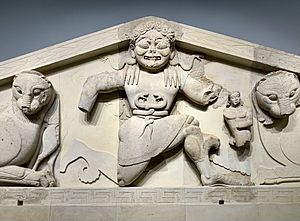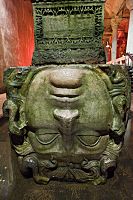Medusa facts for kids
Quick facts for kids Medusa |
|
|---|---|
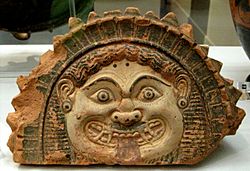
An ancient Greek carving of Medusa's head from the 300s BC.
|
|
| Personal information | |
| Children | Pegasus and Chrysaor |
| Parents | Phorcys and Ceto |
| Siblings | The Hesperides, Sthenno, Euryale, The Graea, Thoosa, Scylla, and Ladon |
In Greek mythology, Medusa (which means "guardian" or "protectress") was a famous monster. She was one of three sisters called the Gorgons. These sisters were winged women with living, venomous snakes instead of hair. If anyone looked into Medusa's eyes, they would instantly turn to stone. Most stories say her parents were Phorcys and Ceto, who were ancient sea gods.
A brave Greek hero named Perseus eventually cut off Medusa's head. Even after she was beheaded, her head still had the power to turn people to stone. Perseus used it as a weapon. Later, he gave it to the goddess Athena, who placed it on her special shield. In ancient times, people used images of Medusa's head, called a Gorgoneion, to ward off evil.
Some old stories say Medusa lived and died in a place called Sarpedon. Others, like the writer Dionysios Skytobrachion, believed she lived in Libya. The historian Herodotus even thought her myth came from the Berbers in Libya.
Medusa's Story
Medusa and her two sisters, Stheno and Euryale, were the three Gorgons. They were children of the sea gods Phorcys and Ceto. These parents were seen as ancient, monstrous beings from a very old world. The Gorgons also had other monstrous sisters, the Graeae. The writer Aeschylus described them living "on Kisthene's dreadful plain," saying: "Near them their sisters three, the Gorgons, winged With snakes for hair—hatred of mortal man"
At first, ancient Greek artists showed Medusa and her sisters as truly monstrous. But later, around the 400s BC, sculptors and painters began to show her as both beautiful and terrifying. A poet named Pindar even wrote about "fair-cheeked Medusa" in 490 BC.
A later version of Medusa's story comes from the Roman poet Ovid. He wrote that Medusa was once a beautiful young woman. But when the sea god Neptune (who is also Poseidon) fell in love with her, the goddess Minerva (who is also Athena) punished Medusa. Minerva changed Medusa's lovely hair into horrible snakes.
In most versions of the story, the hero Perseus was sent to get Medusa's head. King Polydectes of Seriphus sent him on this dangerous quest because he wanted to marry Perseus's mother. The gods knew about this plan and helped Perseus. He received a shiny shield from Athena, winged sandals from Hermes, a strong sword from Hephaestus, and Hades's helm of invisibility (a helmet that made him invisible).
Medusa was the only one of the three Gorgons who could die. Perseus was able to kill her by looking at her reflection in the mirrored shield Athena gave him. This way, he avoided looking directly into her eyes. At the time, Medusa was pregnant by Poseidon. When Perseus cut off her head, two beings sprang from her body: Pegasus, a famous winged horse, and Chrysaor, a giant warrior with a golden sword.
Afterward, Perseus flew over northwest Africa. According to Ovid, he passed the giant Atlas, who held the sky on his shoulders. When Atlas tried to attack him, Perseus used Medusa's head to turn Atlas into stone. The story also says that the coral in the Red Sea was formed from Medusa's blood. This happened when Perseus placed her head on seaweed near the shore. He was in Ethiopia at the time, where he saved and married the beautiful princess Andromeda.
It is also said that the poisonous snakes of the Sahara desert grew from drops of Medusa's blood. Her blood also created the Amphisbaena, a creature like a horned dragon with a snake-headed tail.
Perseus then flew back to Seriphos. There, his mother was being forced to marry King Polydectes. Perseus used Medusa's head to turn the king into stone. Finally, Perseus gave the Gorgon's head to Athena, who placed it on her shield, the Aegis.
-
An ancient Roman carving of Medusa, now used as a column base in the Basilica Cistern.
-
Coins from the time of Seleucus I Nicator of Syria (312–280 BC).
Medusa in Art
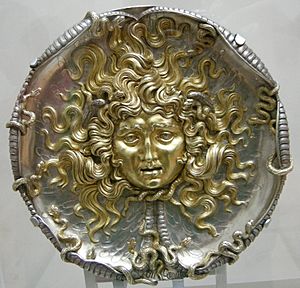
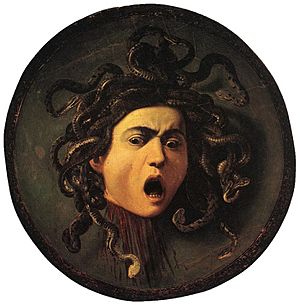
Medusa has been a popular subject in many artworks throughout history. Here are some examples:
- Perseus beheading the sleeping Medusa, a jar painted by Polygnotos (vase painter) (around 450 – 440 BC). It is now in the Metropolitan Museum of Art.
- Medusa on the chest armor of Alexander the Great, shown in the Alexander Mosaic from Pompeii (around 200 BC).
- Medusa column bases found in the Basilica Cistern in Constantinople.
- The "Rondanini Medusa", a Roman copy of the Gorgoneion on Athena's shield. This was later used as a model for the head in Antonio Canova's marble statue Perseus with the Head of Medusa (1798–1801).
- Medusa (oil painting) by Leonardo da Vinci.
- Perseus with the Head of Medusa (bronze sculpture) by Benvenuto Cellini (1554).
- Perseus and Medusa – a bronze statue by Hubert Gerhard (around 1590).
- Medusa (oil painting) by Caravaggio (1597).
- Head of Medusa, by Peter Paul Rubens (1618).
- Medusa (marble bust) by Gianlorenzo Bernini (1630s).
- Medusa is a character in the opera Persée (1682) by Jean-Baptiste Lully and Philippe Quinault. She sings an aria about losing her beauty.
- Perseus Turning Phineus and his Followers to Stone (oil painting) by Luca Giordano (early 1680s).
- Perseus with the Head of Medusa (marble sculpture) by Antonio Canova (1801).
- Medusa (1854), a marble sculpture by Harriet Hosmer, now in the Detroit Institute of Art.
- Medusa (oil painting) by Arnold Böcklin (around 1878).
- Perseus (bronze sculpture) by Salvador Dalí.
- Medusa sculpture by Luciano Garbati, which shows her holding Perseus's severed head (2008).
Medusa remained a popular subject in art during the 1800s. Her story was retold in Thomas Bulfinch's Mythology. Paintings by Edward Burne-Jones and drawings by Aubrey Beardsley led to more modern works. Artists like Paul Klee, John Singer Sargent, Pablo Picasso, Pierre et Gilles, and Auguste Rodin (with his bronze sculpture The Gates of Hell) also depicted Medusa.
Flags and Emblems
Medusa's head is also seen on some regional symbols. For example, it is on the flag and emblem of Sicily, along with the three-legged trinacria. Having Medusa in the center suggests protection from the goddess Athena, who wore Medusa's image on her shield. Another example is the coat of arms of Dohalice village in the Czech Republic.
-
The coat of arms for Dohalice village in the Czech Republic.
-
A ceremonial French military uniform belt from World War I.
|
See also
 In Spanish: Medusa (mitología) para niños
In Spanish: Medusa (mitología) para niños


